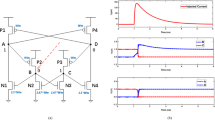Abstract
In a modern high density VLSI design, with higher operating frequency and technology scaling, small critical charge in circuit nodes significantly increases susceptibility to radiation induced transient faults. In this paper, we propose a high efficiency hardened latch using the undesired delay of Schmitt trigger circuit and a special feedback loop to a comparator to build a low overhead time redundancy scheme. The proposed structure masks internal node transient faults also improves the recovery of the output node by transferring the faulty output in two different paths to the comparison circuit’s inputs. Experimental results, simulated in 45 nm CMOS technology, show an acceptable increase in the critical charge compared with the previous hardened latches, with a fair increase in power, delay and area. Monte Carlo simulations have also confirmed the proposed latch resistance to the process, voltage and temperature variations.











Similar content being viewed by others
References
Avirneni NDP, Somani AK (2012) Low overhead soft error mitigation techniques for high-performance and aggressive designs. IEEE Trans Comput 61:488–501. doi:10.1109/TC.2011.31
Baumann RC (2005) Radiation-induced soft errors in advanced semiconductor technologies. IEEE Transactions on Device and Materials Reliability. IEEE Trans Device Mater Reliab 5:305–316. doi:10.1109/TDMR.2005.853449
Berkeley predictive technology model (2007) http://www.eas.asu.edu/~ptm/
Calin T, Nicolaidis M, Velazco R (1996) Upset hardened memory design for submicron CMOS technology. IEEE Trans Nucl Sci 43:2874–2878. doi:10.1109/23.556880
Carreno VA, Choi G, and Iyer RK (1990) Analog-digital simulation of transient-induced logic errors and upset susceptibility of an advanced control system. In NASA Tech Memorandum 4241
Cha H, Patel JH (1993) A logic-level model for α-particle hits in CMOS circuits. Proc IEEE Int Conf Comput Des :538–542. doi:10.1.1.34.8586
Chen M, Orailoglu A (2009) Flip-flop hardening and selection for soft error and delay fault resilience. In Proc IEEE Int Symp Defect Fault Tolerance VLSI Syst :49–57. doi:10.1109/DFT.2009.50
Choi Y, Kim Y, Lombardi F (2012) Soft error masking latch for sub-threshold voltage operation. In Proc IEEE Int Midwest Symp Circuits Syst :25–28. doi:10.1109/MWSCAS.2012.6291948
Dodd PE, Massengill LW (2003) Basic mechanisms and modeling of single-event upset in digital microelectronics. IEEE Trans Device Mat Rel 50:583–602. doi:10.1109/TNS.2003.813129
Hazucha P, Karnik T, Walstra S, Bloechel BA, Tschanz JW, Maiz J, Soumyanath K, Dermer GE, Narendra S, De V, Borkar S (2004) Measurements and analysis of SER-tolerant latch in a 90-nm dual-VT CMOS process. IEEE J Solid State Circuits 39:1536–1543. doi:10.1109/CICC.2003.1249472
Karnik T, Hazucha P, Patel J (2004) Characterization of soft error caused by single event upsets in CMOS processes. IEEE Trans Depend Secure Comput 1:128–143. doi:10.1109/TDSC.2004.14
Kim L-S, Dutton RW (1990) Metastability of CMOS latch/flip-flop. IEEE J Solid State Circuits 25:942–951. doi:10.1109/4.58286
Lin S, Kim YB, Lombardi F (2011) Design and performance evaluation of radiation hardened latches for nanoscale CMOS. IEEE Trans Large Scale Integr (VLSI) Syst 19:1315–1319. doi:10.1109/TVLSI.2010.2047954
Mitra S, Zhang M, Waqas S, Seifert N, Gill B, Kim KS (2006) Combinational logic soft error correction. In Proc IEEE Int’l Test Conf :824–832. doi:10.1109/TEST.2006.297681
Omana M, Rossi D, Metra C (2003) Novel transient fault hardened static latch. In Proc IEEE Int Test Conf :886–892. doi:10.1109/TEST.2003.1271074
Omana M, Rossi D, Metra C (2007) Latch susceptibility to transient faults and new hardening approach. IEEE Trans Comput 56:1255–1268. doi:10.1109/TC.2007.1070
Rey DM (2009) The MOSIS Service. http://www.mosis.org/Technical/Designrules/scmos/scmos-main.html
Sasaki Y, Namba K, Ito H (2006) Soft error masking circuit and latch using Schmitt trigger circuit. In Proc IEEE DFT :327–335. doi:10.1109/DFT.2006.60
Seifert N, Zhu X, Massengill LW (2002) Impact of scaling on soft error rates in commercial microprocessors. IEEE Trans Nucl Sci 49:3100–3106. doi:10.1109/TNS.2002.805402
Zyuban V (2003) Optimization of scannable latches for low energy. IEEE Trans Very Large Scale Integr (VLSI) Syst 11:778–788. doi:10.1109/TVLSI.2003.814322
Author information
Authors and Affiliations
Corresponding author
Additional information
Responsible Editor: C. A. Papachristou
Rights and permissions
About this article
Cite this article
Niaraki Asli, R., Shirinzadeh, S. High Efficiency Time Redundant Hardened Latch for Reliable Circuit Design. J Electron Test 29, 537–544 (2013). https://doi.org/10.1007/s10836-013-5384-x
Received:
Accepted:
Published:
Issue Date:
DOI: https://doi.org/10.1007/s10836-013-5384-x




